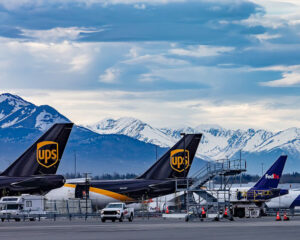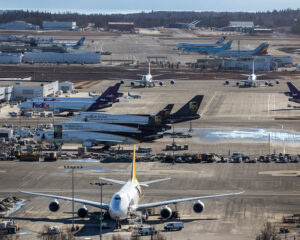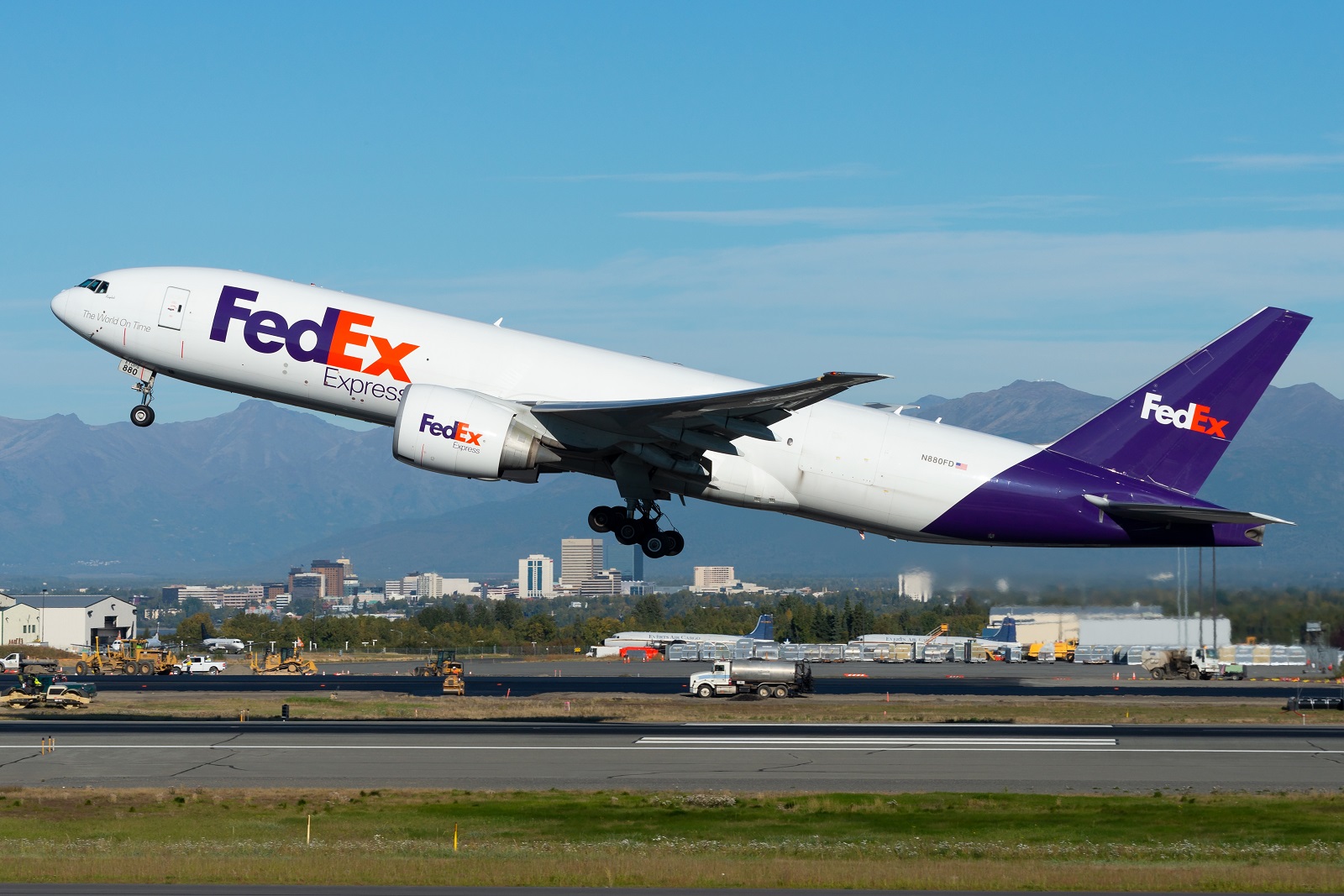Anchorage’s geographical location is perfectly placed for travel between Asia and North America, equidistant between cities such as Tokyo and New York. By using Anchorage as a halfway point, cargo carriers can maximise cargo payloads with lower fuel requirements.
But with those advantages, Anchorage also brings unique challenges. Based in the heart of Alaska, Anchorage is a winter city and relies on an exceptional, award-winning snow removal team to keep its operations running smoothly.
Anchorage International Airport is also a work in progress, with a number of ongoing development projects in the works. When we talked to Airport Director Craig Campbell it is clear he is excited about what they have planned.
A Hub for Cargo
Anchorage International Airport was the world’s third busiest air cargo airport in 2022. In 1996, the United States government granted Anchorage International Airport expanded air cargo transfer rights, which provides cargo carriers with exclusive opportunities to use Alaska as a cost-effective transfer point for cargo between Asia and North America.
“FedEx is expanding their hub here in Anchorage,” Campbell tells us. “They have already expanded three times and are now expanding a fourth time to provide capacity for the next generation Boeing777 freighter aircraft and more efficient regional operations throughout Alaska.”
This is alongside a third-party development by NorthLink Aviation, which is building an expansive cargo apron on the south side of the airport.
“This will be a state-of-the-art facility offering additional aircraft parking positions for 747-sized cargo aircraft and incorporating advanced technology with an innovative, environmentally clean, aircraft de-icing fluid recycling system. The development will include aircraft refuelling and electrical power at each aircraft parking position, reducing both noise and air contamination while aircraft are parked at Anchorage International Airport,” Campbell says. “It will also include a warehouse facility with customs clearance capabilities.”
Campbell is the first to acknowledge that the cargo sector is undergoing an evolution right now, as e-commerce and e-logistics are massively expanding as markets.
 “They will be the future of how packages are shipped,” Campbell says simply. “So, we are starting an e-marketplace program that will allow cargo customers to go online and book shipments of commodities from point A to point B through an e-commerce system.”
“They will be the future of how packages are shipped,” Campbell says simply. “So, we are starting an e-marketplace program that will allow cargo customers to go online and book shipments of commodities from point A to point B through an e-commerce system.”
This is not the only way that Anchorage International Airport is expanding its offering, however. Campbell is finding new ways for the airport to leverage its unique position.
“Traditionally, if you look at air cargo from Asia to North America, it is fast but expensive,” Campbell says. “A much cheaper way to ship goods is by surface transportation, using maritime shipping from Asia, connecting to the road and rail system on the west coast of North America, but this is slow and usually takes about 30 days for freight to reach its destination. To provide another alternative, we are establishing a new program called the Alaska Pass that offers a hybrid,”
Under this system, cargo flies into Anchorage and can clear customs or remain in bond until delivery at the cargo’s destination. In Anchorage, the cargo is transferred to the Port of Alaska and put on a ship to Seattle where it then can be transported by road or rail to its final destination. While shipping freight from Asia to North America solely by air is normally completed within 24 hours, and surface transport can take up to 30 days, using the Alaska Pass will take in the region of two weeks, providing the perfect middle ground between speed and costs.
Over the last year, Anchorage International Airport conducted a trial of Alaska Pass with a cargo run from Korea, through Anchorage, down to Seattle and on to Chicago. The test validated that Alaska Pass can meet customer requirements within 14 days. The offering is expected to be fully operational next year.
A Hub for Passengers
As well as cargo, Anchorage International Airport serves as a valuable through-point for corporate and private aircraft travelling between Asia and North America.
“A lot of corporate jets from Asia stop here to clear customs and refuel, so this year Signature Aviation opened a new facility to support those corporate operations,” Campbell says. “Signature expects 70% of their activity to be international flights, which will add another dynamic to the airport’s growth.” The new facility includes customs clearance and aircraft ground services.
At the same time, Anchorage International Airport’s location in Alaska means that it also hosts some more unique amenities.
 “This international airport is co-located with the world’s busiest floatplane facility,” Campbell says. “It is the busiest float plane seaplane operation in the world, especially in the summertime. Tourists come over on the large jets, transfer to the floatplane facility and fly out to hunting lodges, camping sites, and river fishing, as Alaska has a very limited road system.” “It is truly a unique Alaskan experience,” he said.
“This international airport is co-located with the world’s busiest floatplane facility,” Campbell says. “It is the busiest float plane seaplane operation in the world, especially in the summertime. Tourists come over on the large jets, transfer to the floatplane facility and fly out to hunting lodges, camping sites, and river fishing, as Alaska has a very limited road system.” “It is truly a unique Alaskan experience,” he said.
Passengers who live, work and travel to and from Alaska form a consistent baseline for the airport’s passenger levels. The airport is the largest in the state and the primary connection point for air travel throughout Alaska. But at the same time, the airport experiences a significant increase in passenger traffic during the summer months, generated by a robust tourism industry, supporting a large number of cruise passengers.
“We get increased activity in the summer from the cruise business,” Campbell says. “We are seeing the best numbers we have ever had, exceeding our peak 2019 passenger enplanements. As the cruise and tourist industries grow there will be more demand to get to or pass through Alaska.”
Of course, both the passenger and cargo divisions of the airport’s business depend upon the quality of its people, and Campbell is passionate about Anchorage International Airport’s role as an employer.
“Anchorage International Airport provides one in seven jobs to the Anchorage metropolitan area with a positive $1.84 Billion (USD) annual economic impact to the state. We have a skilled labour pool to draw upon,” Campbell says. “The University of Alaska, Anchorage has an engineering program, an aviation program, and a global and logistics supply chain program. Many of the skills needed here at the airport are taught there.”
Alaska is a natural resource development state that depends on the oil industry. There are a lot of industrial companies supporting that sector in the city, which feeds back into many of the skillsets that Anchorage International Airport relies on.
“For the past couple of years recruitment was difficult because of the Covid pandemic, but we’re nearly back at full staffing now with incentive programs and scheduling flexibility,” Campbell says. “We are also working with labour unions to make sure they can provide the skillsets we need.” “We have some of the most professional and dedicated staff in the industry,” he concluded.
Flight to the Future
 As well as ensuring there is a pipeline of skilled workers, Anchorage International Airport is also ensuring its future in other ways.
As well as ensuring there is a pipeline of skilled workers, Anchorage International Airport is also ensuring its future in other ways.
“Sustainability is a key interest to the aviation business across the globe,” Campbell insists. “We are just starting a master plan for the airport to investigate our growth needs for the next decade, and sustainability is a key topic. We will evaluate investing in clean energy sources, like solar and wind power. As aircraft transition to more environmentally friendly fuels, we will be considering areas where we can locate biofuel storage tanks. As the technology improves, we will transition our ground support fleet to electric vehicles and provide electric vehicle charging station capabilities for our travelling customers. The master plan will be looking at sustainability as a major focus to meet projected demand for the next decade.”
Campbell is committed to realising Anchorage International Airport’s vision to continue to be an economic hub for the state of Alaska and meeting the needs of North America as it grows its air cargo and passenger service.







